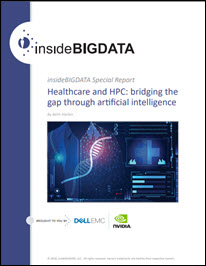This insideAI News special report series explores the intersection of AI and healthcare. To kick things off, this post delves into the application of AI within healthcare, as well as the impact and challenges of these new tools and uses.

Download the full report.
Current applications
Through machine learning, a subclass of AI, computers can process large amounts of structured and/or unstructured data to begin to recognize patterns, make predictions and essentially “learn” the solution to a given problem. The drawback is that machine learning requires humans to physically input the parameters for what the computer needs to recognize. Those inputs can be time-consuming, so we go one step further into deep learning. Machine learning and deep learning build the fundamentals to an AI system, and by taking a holistic approach to the data being generated within healthcare, AI-enabled systems can help to assess risk and facilitate improved human decision making. For example, algorithms can train models to measure and monitor elements, such as tumors, within diagnostic and imaging tools like MRIs, CT and PET scanners, and traditional X-rays.
Machine learning and deep learning build the fundamentals to an AI system, and by taking a holistic approach to the data being generated within healthcare, AI-enabled systems can help to assess risk and facilitate improved human decision making.
An AI program can detect changes with a level of speed and accuracy far greater than humans can. For example, a trained deep learning model can complete identification of 14 different diseases/conditions in chest X-rays in less than one second, according to data scientists in the Dell EMC HPC and AI Innovation Lab. AI assistance can drastically shorten the time to diagnosis, while letting the clinician focus on treatment.
Impact
AI is already having a profound impact on patient care. Faster processing speeds and models trained to identify nuances that may escape the human eye have led to earlier diagnoses and improved risk identification. Further benefits include reduced cancer treatment times, accelerated genetic analysis, faster development of custom treatments and reduced treatment costs.
Challenges
The quality and accuracy of the AI model is dependent upon the quality and volume of the data used to train it. As with all heavily regulated industries, concerns surrounding the digitalization, sharing and security of personal medical data are a challenge. Any growth in the application of AI will need to come from within medical groups and be done in concert with insurance providers, as well as relevant government entities.
Interested in learning more about AI within healthcare? This insideAI News special report series will also cover the following aspects of AI in the healthcare industry over the next few weeks:
- The results of the use of AI in healthcare, including:
- Cancer research
- Radiology studies
- Diagnostic research
- Finding an AI solution
- What’s next?
Download the full insideAI News special report, “Healthcare and HPC — Bridging the Gap Through Artificial Intelligence,” courtesy of Dell EMC and NVIDIA, to learn more about how AI is impacting the healthcare industry.





Speak Your Mind